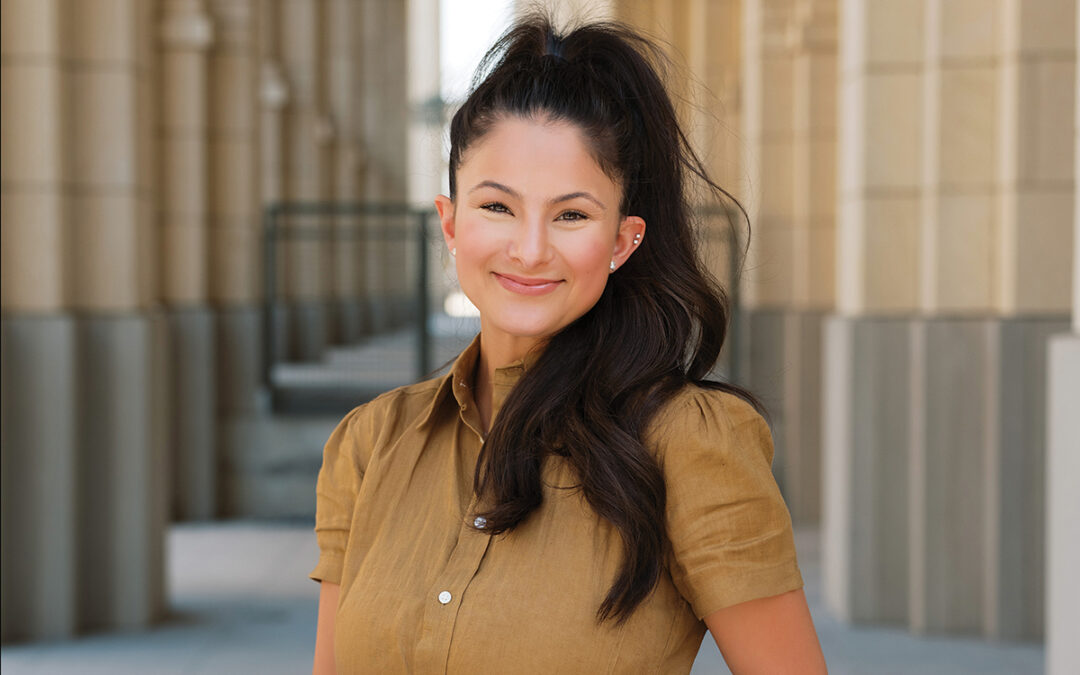On most nights, Belinda Menchaca can be found in the dance studio at the Institute of Mexico, where she conducts rehearsals of the Guadalupe Dance Company.
It’s a handsome space, with the right kind of floor, mirrored walls and a lot of room for dancers to practice their moves. Even though the company — as its name implies — is based at the Guadalupe Cultural Arts Center (GCAC), the Institute makes its facilities available free of charge. It works well for everybody.
On this particular night in June, Menchaca finishes teaching a flamenco class to a mixed-age group of students before turning her attention to the assembled company members. A performance is scheduled for the upcoming Saturday, and there is no time to lose. Since they are short one couple, the dancers spend some time in silence figuring out new spatial configurations. It looks rather chaotic for a while, but then the music starts and the studio fills with the exuberance of the dance, a piece from the Mexican state of Sinaloa.
“At this level (of experience) they are all very good at solving problems,” says Menchaca matter-of-factly. “This is the first time we are reviewing these dances since we premiered them in early May, so there are always a few kinks to take out.”
A few minutes later, she lets program assistant Jeannette Chavez take over in the studio while she guides her visitor to the art gallery next door for a quiet conversation.
“The way I designed the program from the beginning allowed company members to develop as choreographers as well as dancers,” she explains as we sit down. “So Jeannette is the choreographer for this one. Besides myself, we have four other choreographers in the group. Saturday we’ll perform three sets of dances from three different Mexican states.
“Our mission,” she continues, “is to preserve and present the rich heritage of Mexican and Spanish dance. Most people are familiar with the dances from Jalisco, with the swirling skirts and mariachis, but there are 30 other states in Mexico that have distinct styles and costumes. That’s wonderful for us because there is so much to learn and explore. And that’s just Mexican folk. We do a lot of other things.”
An experienced flamenco dancer, Menchaca has been associated with the Guadalupe dance program since its beginning in 1991. In the past, other groups had tried to form a professional Hispanic dance ensemble here, but none had enough money and management know-how to endure. Yet many have felt that San Antonio should have at least one such company.
“There was so much talent in San Antonio, and there always has been, but no place for these talented artists to show their skills,” recalls Menchaca, who took the reins of the company in 1992. “In the early ’90s, it was really the right moment for the GCAC to start something like this. It already had programs in music, in theater, in the visual arts, but no dance. There had been only schools before. It’s good to train young dancers, but you have to give them a goal, a place to perform in this city on a professional level instead of nurturing them and seeing them leave San Antonio.”
What made the new company more likely to survive than its predecessors was its affiliation with GCAC. Not only did the center already have a staff savvy in grant writing and administration, but its then-director, Pedro Rodriguez, also obtained financial support from the city and the Mexican Cultural Institute. Though money is always tight, this was an auspicious start.
When she became the director, Menchaca implemented a two-part program consisting of both a school, The Guadalupe Dance Academy, and the adult company. The latter is unique in the United States because it specializes in both Spanish and Mexican dance. She then proceeded to develop an ever-growing repertoire by exposing her dancers and herself to a process of learning from master instructors. Guest choreographers from Mexico were invited here to work with the ensemble, and each summer, members also attend the Asociacion Nacional de Grupos Folk (ANGF) conference, where they spend a week in intense study.
Today, the Guadalupe Dance Company produces four major shows a year in addition to performing for special events, taking part in the Folkl97rico Festival of Dallas each April and offering lectures/demonstrations to hundreds of school kids. Members also teach in the academy and occasionally go on weekend tours. What’s more, the group also cultivates the Spanish classical style, choreographed personally by Menchaca, and showcased in several appearances with the San Antonio Symphony and two other symphonic orchestras.
When they perform, Menchaca and her colleagues try to invoke the atmosphere of the region from which the particular numbers originated. Regional styles differ in colors, body posture, skirt work, footwork, the roles of men and women, and in context, she says, the result of different cultural influences.
As if all of the above weren’t enough, the company occasionally stretches itself even further. To the delight of both dancers and audiences, it also develops original new works that combine elements of traditional folklore with ballet and modern dance. One such work was the beautiful 2001 show Santuarios choreographed by Serafin Aponte from Mexico to the music of Puerto Rican-American composer Lourdes Perez. The work uses the metaphor of the monarch butterfly to explore issues of borders, migration and finding a sanctuary, largely through modern dance. Another example is Rio Bravo, a sort of chronicle of the evolution of music and dance along the U.S.-Mexico border from Aztec times to Tejano. This piece is still being staged from time to time.
In love with dance
The driving force behind this artistic engine is undeniably Menchaca. A dancer since age 10, little Belinda fell in love with flamenco after her parents took her to see a performance of this passionate Spanish tradition. Soon after, she was taking classes through the Parks & Recreation program, where a teacher advised her to add ballet to her training. When the flamenco diva La Chiqui and her husband, guitarist Jose Linares, formed their Compa9692a de Arte Espa96ol here in 1977, Menchaca became one of the principal dancers, staying and refining her craft until 1990. Along the way, she also spent some time in Madrid, studying Spanish classical dance.
As the director, Menchaca now handles everything from administrative duties and rehearsals to artistic goals and choices. Sunday is the only time she has for home life with her husband of 20 years, Felipe Vasquez. She has no children, she says, because “this is my life,” from 10 a.m. to 10 at night. She has also served the wider dance community in San Antonio as president of the Dance Umbrella and as a peer review panelist for both the Office of Cultural Affairs and the National Endowment for the Arts Expansion Arts program.
Few dancers ever get the opportunity to shape a company, commission new works and affect a community. So, is this job a dream come true for her?
“I feel very fortunate, but I never really dreamed of this,” she says honestly. “I knew I would always dance and teach, but I never thought I would be the director of a dance company. When the opportunity arose, however, I knew I couldn’t pass it up.”
Besides the immediate goals of getting ready for the next show or the next year, Menchaca has a long-term goal that she cares deeply about. At present, the dancers are paid per performance, but the director dreams of the day when she will be able to pay them full-time salaries. It’s not always easy to retain performers who must make a living elsewhere.
Mexican-born-and-trained dancer Jorge Gaxiola understands Menchaca’s concern and gives her credit for nurturing the company under the present circumstances. “Sometimes it’s hard to keep the company together because people have (other) jobs and cannot always show up, and it’s also hard to find men for the company. But Belinda knows how to motivate people and keep everything going. She is really good at that,” he says.
While Gaxiola already had a vast knowledge of Mexican dance prior to joining the group, Dava Hernandez was primarily into tap, jazz and ballet before she became a member in 1999. She’s learned a great deal since, not only about folkl97rico but about Mexican-American culture as a whole. As an artist, she likes the opportunity the company has given her to develop on all three fronts, as dancer, choreographer and instructor. “Belinda encourages and nurtures you as an artist. That’s how she’s built this company,” says Hernandez.
Saturday night
A few days later, the Guadalupe Theater is all decked out for a grand evening, complete with dinner, silent and live auction and lots of music. Dubbed “The 1st Annual Tejano Music Night Gala,” the event is a fund-raiser for GCAC’s educational programs. Despite the name, however, it’s a mariachi group that first entertains the crowd. Then, following some speechifying, the dancers in Sinaloa costumes burst onto the scene, and the room comes alive with excitement. Skirts swirl, feet thunder, shoulders undulate and smiles flash. It’s hard to keep one’s own feet still because the joyous beat is so driving.
The evening is not a major showcase for the dance company, but they nevertheless offer an excellent short demonstration of their skills. The Sinaloa set is followed by numbers from Guerrero and eventually Baja California. Each time, the steps and style change rather dramatically. The Baja dances don’t even look “Mexican,” with men in jeans and cowboy hats and women clad in short, straight jeans dresses. Not a swirling skirt in sight. Here the movements are extremely vigorous, the body posture much looser, feet kick up high. You would think you were in Texas.
As the night mellows into a social dance, Menchaca is already thinking about the next day, when the children of the academy are scheduled to perform at Market Square. There is always something going on. Then in a few weeks, the company will play host to some 700 people from all over the United States who are expected to descend on San Antonio for the annual ANGF conference.
All we are thinking about as we are leaving the gala is that we shouldn’t miss the company’s next full-length production.
Author: Jasmina Wellinghoff
Photographer: Liz Garza Williams









0 Comments